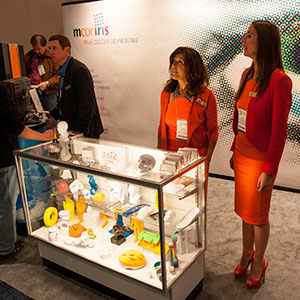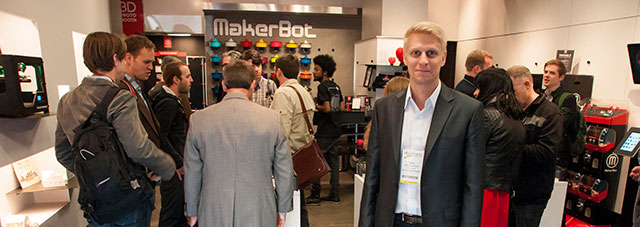More than 1,500 business leaders, investors, entrepreneurs, and enthusiasts attended the Inside 3D Printing Conference and Expo in New York City this week. The jam packed event was a 48 hour review of how the technology has developed over the last few years, and discussion of where it might be headed in the future. Hod Lipson, one of the event’s lead organizers and the author of Fabricated, opened the proceedings with an ambitious question, “How will 3D printing change our lives?” A who’s who of industry leaders was on hand to answer this question, including Avi Reichental of 3D Systems, Bre Pettis of Makerbot and Peter Weijmarshausen of Shapeways. While there was no clear answer, several themes emerged throughout the course of the event that are worth noting.
3D Printing Has Unique Advantages
As a manufacturing technology, 3D printing has unique advantages over its subtractive counterparts. One advantage that was praised time and again throughout the keynotes and sessions was its ability to handle complexity with low cost. 3D Systems’ CEO Avi Reichental reinforced this idea by calling this, “the greatest gift of 3D printing.” In his opening speech, he showcased several examples of how this works in industry, the most striking of which came from the Invisalign Company, which makes a conspicuous alternative to traditional braces. All of the company’s alignment systems are made using 3D Systems printers and each pair must be manufactured to fit an individual’s teeth. This type of custom complexity would be impossible with traditional manufacturing techniques.
Shapeways’ CEO Peter Weijmarshausen spoke about the ability of 3D printing to make consumers a part of the creative process by lowering the cost of customization. “What is missing [in the market],” he said, “is personal input into the products we buy.” Shapeways, a market leader in cloud printing services, is largely devoted to enabling this input. Some of their customers create products and sell them in online stores. Others are able to customize existing creations through services like The Vibe, which provides custom iPhone cases. As 3D printing does not require the use of expensive moulds, the cost of printing one unique thing is not onerous. The investment community believes that Shapeways is on to something. They announced a $30M round of investment during the event, led by powerhouse investment firm Andreessen Horowitz.
(Most of) The Money is Being Made in Industry
Personal 3D printers continue to captivate the imagination of the public, and that interest is growing. According to industry analyst Terry Wohlers, a paltry 1,600 news articles were written about 3D printing in 2011, while 16,000 were written in 2012. While most of these column inches are devoted to personal 3d printing, the vast majority of the money is being made in industry.

Though the consumer 3D printing market is still small in terms of dollars, its growth is impressive. Wohlers’ firm also tracks the number of personal 3D printers (priced at $5000 or less) sold each year. More than 23,000 printers were sold in 2011, a number nearly 400% larger than the year prior. Though final numbers were not available for 2012, the sales increase is expected to be significant.
Our Creative Tools Need Work
Matt Griffin, Director of Community Support at Adafruit, shared an interesting discovery he made during his research for a new book on 3D modeling. Though there is a lot of talk about the ability of 3D printing to help us “print our dreams”, he said, there are relatively “few people designing their dreams right now.” Prominent on the wish list of many conference speakers was a better set of tools for 3D model creation. “Better” generally meant easier to use and designed specifically to support 3D printing. This need is even more pronounced with the recent announcement that TinkerCAD, a popular entry-level 3D design program, would soon cease to exist.

A close relative to 3D modeling is 3D scanning, and many conference attendees voiced a desire to see improved scanning hardware. Like 3D modeling, there are many projects and developments, but no single solution has prevailed.
The Future is Tough to Predict
Most speakers expect continued growth in the 3D printing industry overall, which has enjoyed a compound annual growth rate of 26.4%. Leading this growth is likely to be the medical industry, which is considered the “fastest growth vertical” by companies like 3D Systems. The personal 3D printing market, however, had the most question marks. In order for broad consumer adoption to occur, several key problems still need to be addressed. Chief amongst these is the ease of use and reliability of the printers themselves, and the lack of accessible tools for the creation of 3D content.

To support the further exploration of these topics, organizers have promised an Inside 3D Printing World Tour, hosted in at least four new cities. More information about their plans for the events can be found here.




